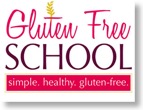Grain-Free for the Gluten-Free
At this stage of the game, you’ve probably heard about some type of low or no carb diet template. As the name suggests, these diets remove all grains - yes, even the gluten-free grains.

Hidden Danger of “Grain Free” Food Companies Don’t Want You to Know
by Jennifer Fugo of GlutenFreeSchool.com
Jennifer’s excellent article explores several facets - benefits and the hidden danger - of grain-free foods.
“Grain free is not (nor may ever be) a safe substitute for gluten free, nor is any sort of paleo certification labeling.“
Full Article: http://bit.ly/1mJMakK
Grain-free diets are known by several different names: Specific Carbohydrate Diet (SCD), Caveman, Ancestral, Paleolithic, Gut and Psychology Syndrome Diet (GAPS), Autoimmune Paleo Diet (AIP), Wheat Belly.
These diets tout a host of benefits that extend beyond a traditional gluten-free diet. Many members of the gluten-free community feel best when they’re grain-free as well.
By definition, grain-free should be gluten-free. “Gluten” is the generic name for the various proteins found in grains. You ditch the grains, you ditch the gluten. It’s a no-brainer! Um, not so fast Slick…
The purpose of this article is to make you aware of an important fact that is not always discussed by the proponents of grain-free diets.
Don't be lulled into a false sense of gluten-free safety by a grain-free food - even though it may be “Paleo Certified”. Sure, the food itself may be naturally gluten-free, but gluten-cross contamination could still be a threat. My concern is for those who may not know to be concerned about cross contact. The unknowing may wonder why they’re not feeling better while being grain-free due to gluten contamination.
Read more: http://bit.ly/1OQVXSN
Gluten contamination of grains, seeds, and flours in the United States: a pilot study - July 2010
Tricia Thompson, MS, RD, Ann Lee, EdD(c), RD, LD, and Thomas Grace
This study tested twenty-two single ingredient naturally gluten-free grains, seeds and flours.
“Gluten contamination of inherently gluten-free grains, seeds, and flours not labeled gluten-free is a legitimate concern.”
Almond flour, coconut flour, chick pea flour, flax seeds (whole or ground), whole nuts of all kinds, herbs, spices, and seasonings are some of the popular ingredients in many grain-free foods. Sure, those are all single ingredient foods - but if these foods are ground, processed, packaged on lines used for gluten containing foods, then the end product could have detrimental levels of gluten.
The bottom-line for those with gluten-related disorders who want to be grain-free - make sure your grain-free foods/ingredients are labeled or certified gluten-free.
Alan Klapperich
GIG of ECW Branch Manager